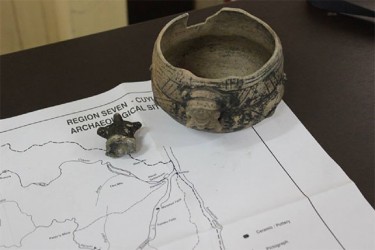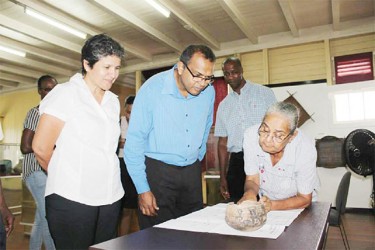An Akawaio pot, estimated to be over 2,000 years old has been presented to the Walter Roth Museum of Anthropology
“The pot, of Akawaio design, was excavated in the course of mining work from under 30 feet of sand at the bottom of the river, and there are flecks of gold [that] can [be] seen at the bottom of the pot,” a press release from the Ministry of Culture, Youth and Sport said, after yesterday’s handing over
Annette Arjoon-Martins presented the ceramic pot to Minister Frank Anthony, who then handed the artefact over to Michael McKenzie, administrator (Ag) of the museum. The pot was found in the 1970s by miner Bernie Leung at Marshall Falls in the Mazaruni area.


According to Arjoon-Martins, Leung had taken the pot with him to Canada when he migrated in 1980, but has decided that it belongs in Guyana and has donated it to the museum. She appealed to miners to make similar donations to contribute to the wealth of Guyana’s national heritage and collection.
In his remarks at the handing over, Anthony said that artefacts found in the interior regions should be kept in Guyana and when such items are found by miners they should deposit them at one of the museums. He further encouraged them to emulate Leung’s example.
The ministry said Quartz Island in the Mazaruni River was one of Dr Denis Williams’s first archaeological excavations. Pottery recovered from this site dates back to 80 BC or just over 2,000 years. It has been established that this river as well as some of its tributaries had been occupied by the Akawaio nation.
The ministry noted that the ceramic vessel represents the Akawabi incised and punctate tradition described by the late Drs Betty Meggers and Clifford Evans in their publication, Archaeological Investigations in British Guiana published in 1960. “The adorno with ‘wavy hair’ on the back has been described by the late Dr Williams as a funerary object. This ‘wavy hair’ can be seen on other funerary objects including the anthropomorphic rattle in the Quelch collection of Carib remains from plantation Mon Repos,” it added.





